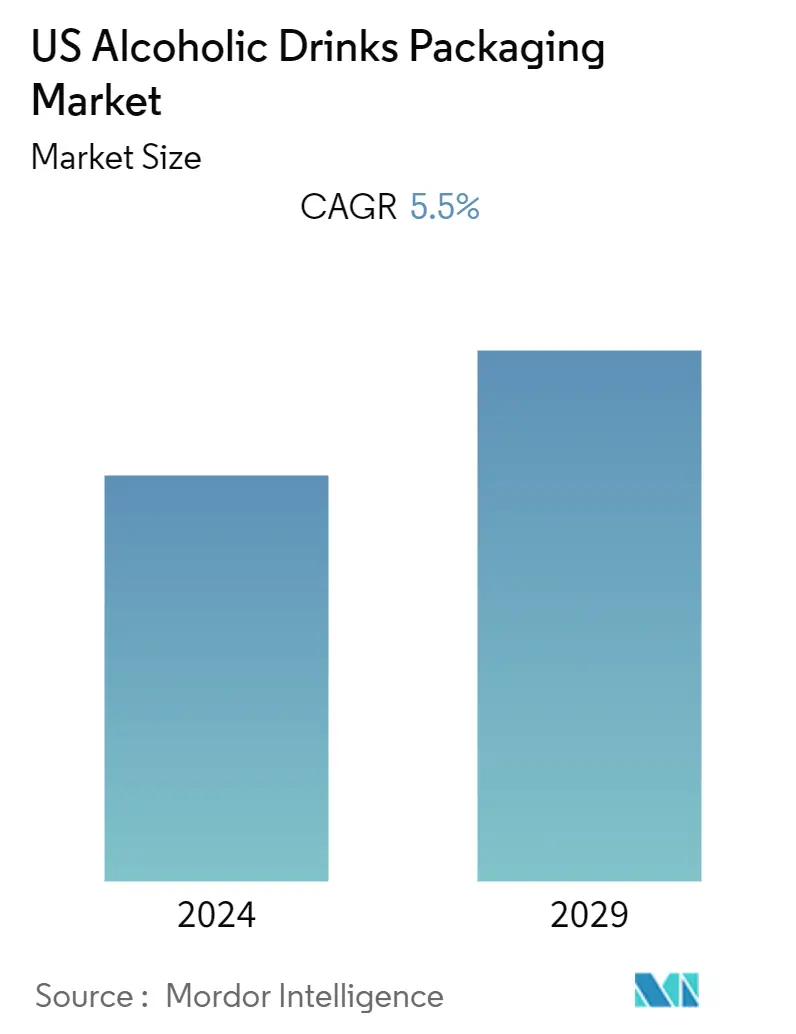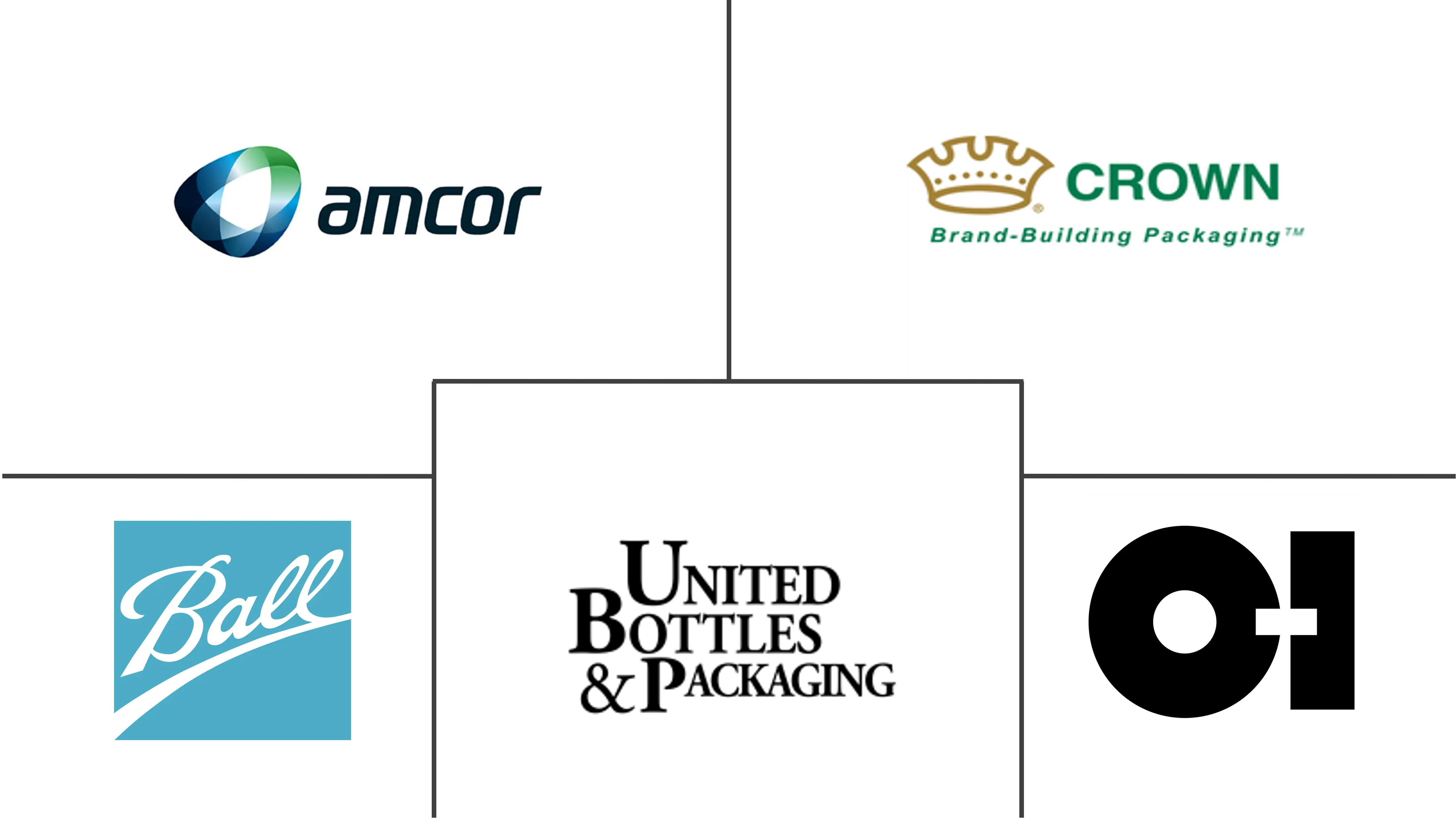Market Size of US Alcoholic Drinks Packaging Industry

| Study Period | 2019 - 2029 |
| Base Year For Estimation | 2023 |
| Forecast Data Period | 2024 - 2029 |
| Historical Data Period | 2019 - 2022 |
| CAGR | 5.50 % |
| Market Concentration | Medium |
Major Players
*Disclaimer: Major Players sorted in no particular order |
US Alcoholic Drinks Packaging Market Analysis
The United States alcoholic drinks packaging market will register a CAGR of 5.5% during the forecast period. The packaging of alcoholic beverages plays a significant role in the brand promotion of alcoholic drinks. It helps brands communicate with their consumers who can touch and feel the product through the packaging.
- The growth of the market depends on serval factors, including the rising consumption of alcohol, the growing demand for metal cans from the craft beer industry, and the increasing use of PET packaging in the alcoholic beverage industry.
- Alcoholic beverage packaging is evolving significantly in terms of design, robustness, and to-go possibilities. Alcohol producers are seeking for innovative ways to represent their brand, reduce carbon emissions, and offer suitable take-out containers.
- Additionally, producers of alcoholic beverages regularly release new products and flavor additions, increasing usage and propelling the market for alcoholic beverage packaging.
- The region's alcoholic beverage packaging market growth is being severely hampered by the growing cost of energy and raw materials, which raises the cost of manufacturing packaging.
- During the outbreak of COVID-19, the market studied faced slow growth due to lockdowns imposed by various countries that have disrupted the supply chain process and the closure of production plants in some countries to curb the effect of the virus.
US Alcoholic Drinks Packaging Industry Segmentation
Alcoholic beverage packaging plays a prominent role in brand promotion, leading to increased brand visibility. At present, alcohol beverage manufacturers are ardent about providing top packaging standards for their products to influence consumers to purchase their brand over others. The various packaging products considered for the study are bottles, metal cans, cartons, and pouches, among others. These products make use of various packaging materials, such as plastic, paper, metal, and glass.
United States Alcoholic Drinks Packaging Market is Segmented Primary Material (Plastic, Paper, Metal, Glass), Alcohol Types (Beer, Spirits, Wine, Ready to Drink (RTD)), and Product Type (Plastic Bottles, Glass Bottles, Metal Cans, Cartons, Pouches). The market sizes and forecasts are provided in terms of value (USD million) for all the above segments.
| By Primary Material | |
| Glass | |
| Metal | |
| Plastic | |
| Paper |
| By Alcohol Type | |
| Wine | |
| Spirits | |
| Beer | |
| Ready to Drink (RTD) | |
| Other Alcohol Types |
| By Product Type | |
| Glass Bottles | |
| Metal Cans | |
| Plastic Bottles | |
| Cartons | |
| Pouches | |
| Other Product Types |
US Alcoholic Drinks Packaging Market Size Summary
The United States alcoholic drinks packaging market is experiencing a notable expansion, driven by several key factors. The increasing consumption of alcohol and the rising demand for metal cans, particularly from the craft beer sector, are significant contributors to this growth. The market is also witnessing a shift towards innovative packaging solutions, such as PET and flexible plastic options, which offer benefits like reduced carbon emissions and enhanced convenience for on-the-go consumption. This evolution in packaging design and material is crucial for brand promotion and consumer engagement, as it allows brands to communicate effectively with their audience. However, the market faces challenges, including the rising costs of energy and raw materials, which impact manufacturing expenses. The COVID-19 pandemic further exacerbated these challenges by disrupting supply chains and causing production slowdowns.
In terms of packaging materials, glass remains a popular choice due to its recyclability and ability to preserve the quality of alcoholic beverages. The demand for glass bottles, particularly for liquor and beer, is supported by their convenience and the increasing use of recycled materials in production. Companies like Absolut are leading the way in sustainability by incorporating recycled glass into their packaging. The market is moderately fragmented, with numerous players offering diverse packaging solutions, intensifying competition. Recent developments, such as Coca-Cola UNITED's partnership with O-I Glass and Owens-Illinois Inc.'s investment in new glass manufacturing facilities, highlight the industry's focus on eco-friendly and sustainable packaging options. These initiatives are expected to further drive the market's growth and enhance the adoption of innovative packaging technologies.
US Alcoholic Drinks Packaging Market Size - Table of Contents
-
1. MARKET INSIGHTS
-
1.1 Market Overview
-
1.2 Industry Value Chain Analysis
-
1.3 Industry Attractiveness - Porter's Five Forces Analysis
-
1.3.1 Threat of New Entrants
-
1.3.2 Bargaining Power of Buyers
-
1.3.3 Bargaining Power of Suppliers
-
1.3.4 Threat of Substitute Products
-
1.3.5 Intensity of Competitive Rivalry
-
-
-
2. MARKET SEGMENTATION
-
2.1 By Primary Material
-
2.1.1 Glass
-
2.1.2 Metal
-
2.1.3 Plastic
-
2.1.4 Paper
-
-
2.2 By Alcohol Type
-
2.2.1 Wine
-
2.2.2 Spirits
-
2.2.3 Beer
-
2.2.4 Ready to Drink (RTD)
-
2.2.5 Other Alcohol Types
-
-
2.3 By Product Type
-
2.3.1 Glass Bottles
-
2.3.2 Metal Cans
-
2.3.3 Plastic Bottles
-
2.3.4 Cartons
-
2.3.5 Pouches
-
2.3.6 Other Product Types
-
-
US Alcoholic Drinks Packaging Market Size FAQs
What is the current US Alcoholic Drinks Packaging Market size?
The US Alcoholic Drinks Packaging Market is projected to register a CAGR of 5.5% during the forecast period (2024-2029)
Who are the key players in US Alcoholic Drinks Packaging Market?
Ball Corporation, Crown Holdings Inc., United Bottles & Packaging, Owens-Illinois Inc. and Amcor plc are the major companies operating in the US Alcoholic Drinks Packaging Market.

